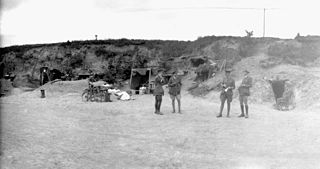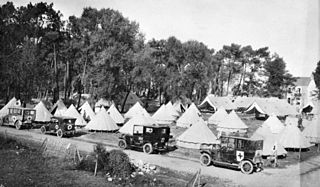The British Expeditionary Force (BEF) was the British Army sent to the Western Front during the First World War. Planning for a British Expeditionary Force began with the Haldane reforms of the British Army carried out by the Secretary of State for War Richard Haldane following the Second Boer War (1899–1902).

The First Australian Imperial Force was the main expeditionary force of the Australian Army during World War I. It was formed on 15 August 1914, following Britain's declaration of war on Germany, initially with a strength of one infantry division and one light horse brigade. The infantry division subsequently fought at Gallipoli between April and December 1915, being reinforced by a second division which was later raised, as well as three light horse brigades. After being evacuated to Egypt the AIF was expanded to five infantry divisions, which were committed to the fighting in France and Belgium along the Western Front in March 1916. A sixth infantry division was partially raised in 1917 in the United Kingdom, but was broken up and used as reinforcements following heavy casualties on the Western Front. Meanwhile, two mounted divisions remained in the Middle East to fight against Turkish forces in the Sinai and Palestine.

The Canadian Corps was a World War I corps formed from the Canadian Expeditionary Force in September 1915 after the arrival of the 2nd Canadian Division in France. The corps was expanded by the addition of the 3rd Canadian Division in December 1915 and the 4th Canadian Division in August 1916. The organization of a 5th Canadian Division began in February 1917 but it was still not fully formed when it was broken up in February 1918 and its men used to reinforce the other four divisions.

General Sir Arthur Henry Fitzroy Paget, was a soldier who reached the rank of General and served as Commander-in-Chief, Ireland, where he was partly responsible for the Curragh Incident.

The United Kingdom's Women's Army Auxiliary Corps, later named the Queen Mary's Army Auxiliary Corps, was the women's unit of the British Army during and immediately after the First World War.

The British War Medal is a campaign medal of the United Kingdom which was awarded to officers and men of British and Imperial forces for service in the First World War. Two versions of the medal were produced. About 6.5 million were struck in silver and 110,000 in bronze, the latter awarded to, among others, the Chinese, Maltese and Indian Labour Corps.

Women in World War I were mobilized in unprecedented numbers on all sides. The vast majority of these women were drafted into the civilian work force to replace conscripted men or work in greatly expanded munitions factories. Thousands served in the military in support roles, e.g. as nurses, but in Russia some saw combat as well.

Dame Emma Maud McCarthy, was a nursing sister and British Army matron-in-chief.

The Fifth Battle of Ypres, also called the Advance of Flanders and the Battle of the Peaks of Flanders is an informal name used to identify a series of battles in northern France and southern Belgium from late September to October 1918.

The I Indian Corps was an army corps of the British Indian Army in the Great War. It was formed at the outbreak of war under the title Indian Corps from troops sent to the Western Front. The British Indian Army did not have a pre-war corps structure, and it held this title until further corps were created. It was withdrawn from the Western Front in December 1915 and reconstituted as I Indian Corps in Mesopotamia until the end of the war.

This is the order of battle for the Battle of the Somme. The Battle of the Somme was an offensive fought on the Western Front during World War I from 1 July to 18 November 1916 as one of the greatest engagements of the war. It was fought between French, British and Dominion forces and the German Empire in the Somme River valley and vicinity in northern France.

The role of Australian women in World War I was focused mainly upon their involvement in the provision of nursing services. Australian women also played a significant role on the homefront, where they filled jobs made vacant by men joining the armed forces. Women also undertook fundraising and recruiting activities as well as organising comfort packages for soldiers serving overseas. Around the issue of conscription, women were involved in campaigning on both sides of the debate, while they were also equally involved in the New South Wales strike in 1917. Nevertheless, despite this involvement, women have never occupied a central position in the Australian version of the ANZAC myth, although since the 1970s their role has been examined in more detail as a result of the emergence of feminist historiography, and specialist histories such as the history of nursing.

The Battle of Haifa was fought on 23 September 1918 towards the end of the Battle of Sharon which together with the Battle of Nablus formed the set piece Battle of Megiddo fought between 19 and 25 September during the last months of the Sinai and Palestine Campaign of the First World War. During the Battle of Haifa, the Indian 15th Cavalry Brigade, 5th Cavalry Division and part of the Desert Mounted Corps attacked rearguard forces of the Ottoman Empire that resulted in the capture of the towns of Haifa and Acre. This attack took place at the north western edge of the Esdraelon Plain 40–50 miles (64–80 km) behind the front line in the Judean Hills after the Desert Mounted Corps had occupied the plain, during the cavalry phase of the Battle of Sharon.

The II Royal Bavarian Reserve Corps / II Bavarian RK was a corps level command of the Royal Bavarian Army, part of the German Army during World War I. The corps only existed for a few months before the Staff was used to form a new Staff for the South Army on the Eastern Front.
The 2nd Mounted Division was a cavalry division that served as part of the Egyptian Expeditionary Force in Palestine in World War I. It was formed in April 1918 when three brigades already in Palestine were merged with elements of the 2nd Indian Cavalry Division withdrawn from the Western Front. In July 1918, the division was renamed as the 5th Cavalry Division. It remained in Palestine after the end of the war on occupation duties until finally broken up in 1920.

The Australian Voluntary Hospital was a military hospital staffed by Australian expatriates in England that served on the Western Front between 1914 and 1916. For much of this time it was the only Australian presence on the Western Front.

The Ottoman Army was reorganized along modern Western European lines during the Tanzimat modernization period and functioned during the decline and dissolution period that is roughly between 1861 and 1918, end of World War I for the Ottomans. The last reorganization occurred during the Second Constitutional Era.
Southern Army was a home service formation of the British Army during the First World War, responsible for the defence of South-East England, including both sides of the Thames Estuary.


















